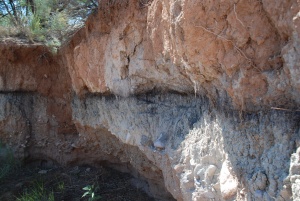Jan 4 2009
Abundant tiny particles of diamond dust exist in sediments dating to 12,900 years ago at six North American sites, adding strong evidence for Earth's impact with a rare swarm of carbon-and-water-rich comets or carbonaceous chondrites, reports a nine-member scientific team.
 Nanometer-sized diamonds occur at the base a layer of sediment directly above the remains of extinct animals (mammoths, dire wolves, etc.) and artifacts from Clovis culture at the research site in Murray Springs, Arizona.
Nanometer-sized diamonds occur at the base a layer of sediment directly above the remains of extinct animals (mammoths, dire wolves, etc.) and artifacts from Clovis culture at the research site in Murray Springs, Arizona.
These nanodiamonds, which are produced under high-temperature, high-pressure conditions created by cosmic impacts and have been found in meteorites, are concentrated in similarly aged sediments at Murray Springs, Ariz., Bull Creek, Okla., Gainey, Mich., and Topper, S.C., as well as Lake Hind, Manitoba, and Chobot, Alberta, in Canada. Nanodiamonds can be produced on Earth, but only through high-explosive detonations or chemical vaporization.
Last year a 26-member team from 16 institutions proposed that a cosmic impact event, possibly by multiple airbursts of comets, set off a 1,300-year-long cold spell known as the Younger Dryas, fragmented the prehistoric Clovis culture and led to the extinction of a large range of animals, including mammoths, across North America. The team's paper was published in the Oct. 9, 2007, issue of the Proceedings of the National Academy of Sciences. (2007 news release | 2007 PNAS paper)
Now, reporting in the Jan. 2 issue of the journal Science, a team led by the University of Oregon's Douglas J. Kennett, a member of the original research team, reports that they've found billions of nanometer-sized diamonds concentrated in sediments -- weighing from about 10 to 2,700 parts per billion -- in the six locations during digs funded by the National Science Foundation.
"The nanodiamonds that we found at all six locations exist only in sediments associated with the Younger Dryas Boundary layers, not above it or below it," said Kennett, a UO archaeologist. "These discoveries provide strong evidence for a cosmic impact event at approximately 12,900 years ago that would have had enormous environmental consequences for plants, animals and humans across North America."
The Clovis culture of hunters and gatherers was named after hunting tools referred to as Clovis points, first discovered in a mammoth's skeleton in 1926 near Clovis, N.M. Clovis sites later were identified across the United States, Mexico and Central America. Clovis people possibly entered North America across a land bridge from Siberia. The peak of the Clovis era is generally considered to have run from 13,200 to 12,900 years ago. One of the diamond-rich sediment layers reported sits directly on top of Clovis materials at the Murray Springs site.
The eight co-authors on the Science paper were: Kennett's father, James P. Kennett of the University of California, Santa Barbara; A. West of GeoScience Consulting in Dewey, Ariz.; C. Mercer of the National Institute for Materials Science in Tsukuba, Japan; Que Hee of the University of California, Los Angeles; L. Bement of the Oklahoma Archaeological Survey at the University of Oklahoma; T.E. Bunch and M. Sellers, both of Northern Arizona University; and W.S. Wolbach of DePaul University in Chicago.